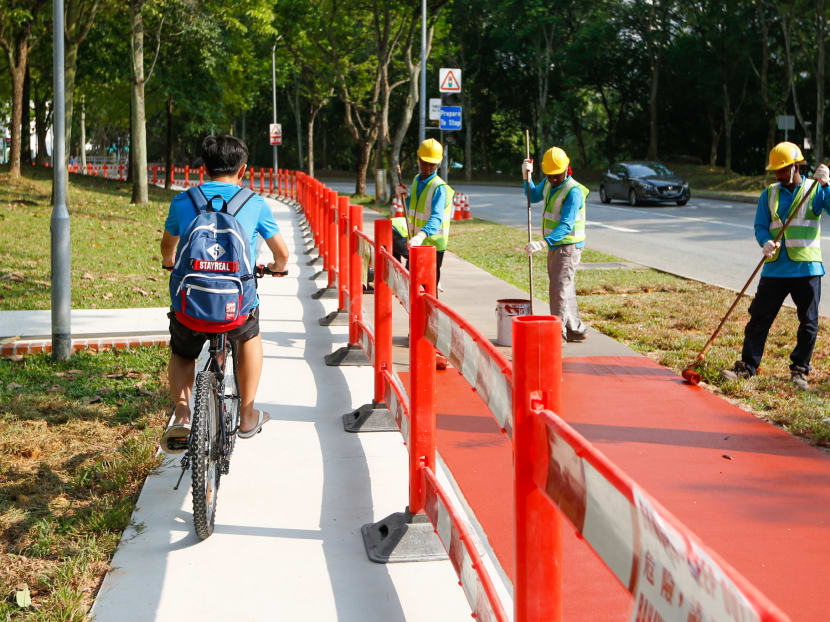Explainer: How are cycling paths built, and why do they cost so much?
SINGAPORE — The Government in January said it would be accelerating the trebling of the cycling path network — from the current 440km to 1,320km — and that the project’s estimated cost would be over S$1 billion. The original target date was 2030.

A cyclist rides by as the shared path along Saujana Road, in the Bukit Panjang area, is painted by workers on March 11, 2020.
SINGAPORE — The Government in January said it would be accelerating the trebling of the cycling path network — from the current 440km to 1,320km — and that the project’s estimated cost would be over S$1 billion.
This 10-figure sum was first mooted by Senior Minister of State for Transport Lam Pin Min, and reiterated in Parliament during the Committee of Supply debate for the Ministry of Transport on March 5. Dr Lam had said the project could be sped up by “a few years”. The target date is 2030.
Some might wonder: Why does the seemingly straightforward procedure of building bicycle paths — even very lengthy stretches — cost so much?
To answer this question, TODAY — led by Land Transport Authority (LTA) representatives — on Wednesday (March 11) visited several stretches of cycling paths in various stages of construction in the Bukit Panjang area, to get an insight into the intricacies of the project and the costs involved.
RECLAIMING ROAD SPACE, ENGAGING STAKEHOLDERS
According to LTA, the “associated infrastructure works”, along with attempts to expedite the construction of cycling path networks, make up the bulk of the S$1 billion estimated cost.
In other words, it’s not so much the cycling path itself, but the work associated with moving things out of the way for it, and doing so in an expedited timeframe.
This work includes relocating bus stops, covered linkways and ramps, the realignment of drains and underground utilities, as well as the transplanting and replanting of trees.
For the cycle path network at Bukit Panjang — which is slated to span 7km and be completed by the end of 2021 — a few of these factors are part of the project.
For example, TODAY observed completed road reclamation works on a 100m stretch along Jelapang Road to ensure that there was enough space for a cycling path to be built adjacent to Covenant Evangelical Free Church.
That is, the footpath “ate into” the road, with the road space for cars narrowed. A one metre-wide strip of the road, which has single lanes in both directions, was taken up and a cycling path is being built on the now-expanded footpath.

A footpath along Jelapang Road on March 11, 2020. The footpath has been widened to be converted into a shared path. Photo: Najeer Yusof/TODAY
Road reclamation is no simple matter.
LTA said that it does “traffic feasibility studies” to assess the impact of reducing road space. For instance, it considers factors like how congested a road may be during peak hours in deciding if it should be reclaimed.
It had also consulted the surrounding stakeholders such as the owners of the church, as well as Greenridge Primary School, which is located opposite the 100m stretch. To minimise the impact on traffic in and out of the school, construction was done mostly last year, during the year-end school holidays.
LTA said that it is working with five schools in the area to create cycling paths around their boundaries.
According to LTA, these are the same considerations it looks at when building cycling paths islandwide, where it “engages many other agencies to assess its technical feasibility and with local stakeholders to ensure that the cycling path plans for the town meet residents’ needs”.
OTHER CONSIDERATIONS
Other features seen by TODAY around Bukit Panjang included retaining walls, which hold back soil when footpaths are widened into adjoining higher ground in order to accommodate the cycling paths. These concrete barriers stand where part of a slope used to be, to prevent the remaining soil from eroding.
Four bus stops in Bukit Panjang are also being reconstructed to make way for cycling paths. This includes making the bus stops narrower to ensure there is enough space behind the bus stops, so that pedestrians and cyclists can interact safely.

The footpath along Fajar Road in the midst of being widened on March 11, 2020, while remaining open to pedestrian traffic. Photo: Yong Jun Yuan/TODAY
The reconstruction and relocation of existing infrastructure is more complicated within more mature and built-up estates such as Toa Payoh and Ang Mo Kio.
LTA said that in new towns such as Tengah and Bidadari, the cycling paths have “already been incorporated into the design and construction plans”.
It added that agencies — such as the Housing and Development Board, National Parks Board and the Public Utilities Board — have “come together to develop a set of guidelines for the different road features”.
“We will follow these planning parameters as far as possible... Where applicable, we will consult the local community to evaluate the trade-offs incurred during cycling path construction.”
SIX WEEKS MINIMUM TO CONSTRUCT 100M STRETCH
LTA said that even without the challenges of dealing with existing infrastructure to accommodate the paths, simply constructing a 100m stretch of cycling path would still take about six weeks, without weather delays.
The process of constructing a bicycle path includes: Building the concrete pavement, preparing and curing of the concrete followed by the coating and painting works to give the paths their distinctive red appearance.
Concrete curing is the process of maintaining adequate moisture in concrete so that it will properly harden, which takes about two weeks.

A student walks along a widened section of the footpath opposite Greenridge Primary School on March 11, 2020. Photo: Yong Jun Yuan/TODAY
TODAY understands that work during the monsoon season may be more frequently delayed due to inclement weather.
For example, should it rain while the paintwork for the path is being added, work will have to be suspended.











